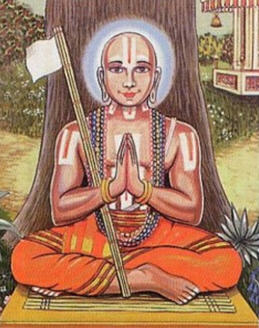
Ramanujacharya
Temples with a large stone deity on the altar generally have a smaller deity called the utsava-murti (“festival form”), who leaves the temple for processions and festivals. The utsava-murti in Melkote is called Tiru Cheluva Narayana (or CheluvaPillai), and the temple is also referred to as the Tiru Cheluva Narayana temple.
During Ramanuja’s twelve years in Melukote, a tyrant named Kullotunga Chola ruled southern India. He could not tolerate any worship of Lord Visnu. Many Vaisnavas fled to Melukote, where they were given refuge by the local people. Moved by the benevolence of the people of Melukote, Ramanuja called them Tirukulattar, “the kind people.”
While in Melukotte, Ramanujacarya in a dream was told by the Lord that the utsava-murti, which had been stolen by invading Moguls, was in Delhi. Ramanujacarya went there with his disciples, met the sultan who had plundered temples in South India, and requested him to return the deity. The sultan showed him several deities, but Ramanuja did not approve any of them. He said that his deity was in the harem of the princess. The sultan told Ramanuja that if he wanted his deity, he would have to ask the deity to come to him.
Ramanuja sang a sweet song and called out, “Please come, my dear child.” (“Cheluva” means “dear child.”) The deity came as a beautiful boy and sat on his lap. Ramanuja embraced the divine child with great affection, calling him Sampad-kumara (“Youthful Lord”), and brought Him to Melukote.
The princess, unable to bear separation from the deity, followed Ramanuja. The sultan then sent his army to accompany the princess, but when they couldn’t enter a rival’s kingdom, the princess continued on alone. When she came to Melukote, she was not allowed to enter the temple, being a Muslim, so she decided to spend her life in penance. Hearing that she was not allowed to see the deity, Ramanuja ordered his disciples to allow her to enter the temple. She walked in and merged with the Lord.
Ramanuja installed a deity of the princess, BibiNachiyar, at the feet of Tiru Cheluva Narayana. Since then every offering made in the temple is done through her.
